FAQs
- What should the customer know about your pricing (e.g., discounts, fees)?
When communicating your pricing to customers, it's important to clearly outline any potential discounts or fees, so they know exactly what to expect. Here's what you could include: 1. **Product Pricing**: Make sure the price for each product or service is clearly stated upfront, including any applicable taxes. 2. **Discounts**: If you're offering any discounts (e.g., bulk purchasing, seasonal sales, promotional offers), explain how customers can qualify and what the terms are. For instance, you could mention specific discount codes or loyalty programs. 3. **Shipping Fees**: If you're charging for shipping, be clear about how much it will cost, whether it’s based on weight, distance, or a flat rate. Also, inform customers if they qualify for free shipping on orders over a certain amount. 4. **Processing Fees**: If you charge an application or service fee, such as for a consultation or for processing orders, make sure customers know about it upfront so it doesn’t come as a surprise. 5. **Payment Methods**: Be transparent about the payment methods you accept and if there are any extra fees for using certain ones (e.g., a service charge for credit card payments). 6. **Refunds & Returns**: Clarify if there are any conditions under which customers can return products or request a refund, and if any fees (restocking, shipping) apply.
- What is your typical process for working with a new customer?
When working with a new customer, it's important to have a clear and structured process to ensure smooth interactions and a positive experience. Here’s a typical process you might follow: 1. **Initial Contact**: - **Introduction**: Reach out to introduce yourself and your business. Briefly explain what you offer and how it can benefit the customer. - **Needs Assessment**: Ask questions to understand the customer’s needs, goals, and expectations. This will help you tailor your services or products to their specific situation. 2. **Proposal/Quote**: - Based on the information gathered during the needs assessment, provide a clear proposal or quote outlining what you're offering, how it addresses their needs, and the pricing. - Be sure to include any applicable discounts, fees, or terms and conditions. 3. **Agreement/Contract**: - If the customer agrees to the proposal, send them a formal agreement or contract. This document should outline the scope of the work, pricing, timelines, and any other important details (like refund policies, payment schedules, etc.). - Allow the customer to ask questions or make changes to the agreement before moving forward. 4. **Onboarding**: - Once the contract is signed, onboard the customer by providing them with necessary information, resources, and expectations. This might include setting up accounts, scheduling meetings, or providing product demos. - If applicable, explain any key steps they need to take on their end to prepare for the service/product delivery. 5. **Execution**: - Begin working on the deliverables as outlined in the contract. Regular communication during this phase is key to ensuring the customer is satisfied with the progress. - Keep the customer updated on milestones, progress, and any issues that may arise. 6. **Delivery/Completion**: - Once the product/service is ready, deliver it as promised and ensure the customer is fully satisfied. - If there are any post-delivery steps (e.g., training, follow-up meetings, product setup), make sure those are carried out. 7. **Feedback & Follow-Up**: - After completing the project, ask for feedback on their experience. This helps you identify areas for improvement. - Continue to check in after the project is completed to ensure the customer is happy and to offer any ongoing support or additional services they may need. 8. **Long-Term Relationship**: - Build long-term relationships with your customers by staying in touch through periodic check-ins, newsletters, or special offers. - Encourage them to refer others or re-engage with you for future projects, offering loyalty discounts or rewards as appropriate.
- What education and/or training do you have that relates to your work?
B.S. in Digital Marketing: This degree provides a strong foundation in digital marketing strategies, SEO, online advertising, social media management, and content creation. It equips you with the tools to run effective marketing campaigns, such as the ones you're using to promote your eBay store and other ventures. Clinical Research Associate Training: As a Clinical Research Associate, you have specialized training in overseeing clinical trials, ensuring compliance with regulations, and managing data and documentation related to research studies. This training allows you to contribute to clinical research studies and manage related projects effectively. Experience with Affiliate Marketing and eCommerce: Your work with affiliate marketing, especially through platforms like Legendary Marketer, and your experience running an eBay store, have given you hands-on experience in sales strategies, customer acquisition, and understanding consumer behavior in the online space. Car Flipping and Dealer Licensing: Through your car dealership contract and work with car flipping, you’ve gained knowledge in vehicle sourcing, sales strategies, negotiation, and understanding the regulatory requirements of operating as a licensed dealer. Content Creation and Marketing: Your experience as a content creator for your YouTube channel and Facebook Ads campaigns has provided you with skills in video production, digital content strategy, and engaging audiences online. You’ve likely also developed expertise in running paid ads and optimizing marketing campaigns to drive sales. Business Management and Consulting: As an entrepreneur managing multiple businesses, you’ve developed skills in financial planning, managing contractors, and scaling businesses. Additionally, your interest in mentoring and working with marketing agencies gives you a well-rounded understanding of business operations and growth. Ongoing Professional Development: You are consistently focused on personal development and business growth, as seen with your plans for continued reading, participation in case studies, and staying current with industry trends.
